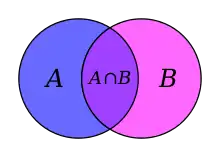جهان فون نویمان
در نظریه مجموعهها و شاخههای مرتبط با آن در ریاضیات، جهان فون نویمان یا سلسله مراتب مجموعههای فون نویمان که با V نشان داده میشود، کلاسی از مجموعههای خوش-بنیان موروثی است. این گردایه، که توسط نظریه مجموعههای تسرملو-فرانکل (ZFC) صوری سازی شده، اغلب جهت ارائه تفسیری برای اصول موضوعههای ZFC یا ایجاد انگیزش برای اصولش مورد استفاده واقع شده. این مفهوم به یاد جان فون نویمان نامگذاری شده، گرچه که اولین بار توسط ارنست تسرملو در ۱۹۳۰ منتشر شد.
رتبه یک مجموعه خوش بنیان به صورت استقرایی به عنوان کوچکترین عدد ترتیبی بزرگتر از رتبههای تمام اعضای مجموعه است.[1] بهخصوص، رتبه مجموعه تهی صفر است، و هر عدد ترتیبی دارای دارای رتبه ای برابر با خودش است. مجموعههای داخل V به سلسله مراتب ترامتناهی تقسیمبندی میشوند که به آن سلسله مراتب تجمعی گفته شده و مبنای آن رتبههایشان است.
ارجاعات
- Mirimanoff 1917; Moore 2013, pp. 261–262; Rubin 1967, p. 214.
- مشارکتکنندگان ویکیپدیا. «von Neumann Universe». در دانشنامهٔ ویکیپدیای انگلیسی، بازبینیشده در ۲۴ آوریل ۲۰۲۱.
منابع
- Bernays, Paul (1991) [1958]. Axiomatic Set Theory. Dover Publications. ISBN 0-486-66637-9.
- Cohen, Paul Joseph (2008) [1966]. Set theory and the continuum hypothesis. Mineola, New York: Dover Publications. ISBN 978-0-486-46921-8.
- Gödel, Kurt (1931). "Über formal unentscheidbare Sätze der Principia Mathematica und verwandter Systeme, I". Monatshefte für Mathematik und Physik. 38: 173–198.
- Gödel, Kurt (1940). The consistency of the axiom of choice and of the generalized continuum-hypothesis with the axioms of set theory. Annals of Mathematics Studies. 3. Princeton, N. J.: Princeton University Press.
- Howard, Paul; Rubin, Jean E. (1998). Consequences of the axiom of choice. Providence, Rhode Island: American Mathematical Society. pp. 175–221. ISBN 9780821809778.
- Jech, Thomas (2003). Set Theory: The Third Millennium Edition, Revised and Expanded. Springer. ISBN 3-540-44085-2.
- Kunen, Kenneth (1980). Set Theory: An Introduction to Independence Proofs. Elsevier. ISBN 0-444-86839-9.
- Manin, Yuri I. (2010) [1977]. A Course in Mathematical Logic for Mathematicians. Graduate Texts in Mathematics. 53. Translated by Koblitz, N. (2nd ed.). New York: Springer-Verlag. pp. 89–96. doi:10.1007/978-1-4419-0615-1. ISBN 978-144-190-6144.
- Mendelson, Elliott (1964). Introduction to Mathematical Logic. Van Nostrand Reinhold.
- Mirimanoff, Dmitry (1917). "Les antinomies de Russell et de Burali-Forti et le probleme fondamental de la theorie des ensembles". L'Enseignement Mathématique. 19: 37–52.
- Moore, Gregory H (2013) [1982]. Zermelo's axiom of choice: Its origins, development & influence. Dover Publications. ISBN 978-0-486-48841-7.
- Peano, Giuseppe (1889). Arithmetices principia: nova methodo exposita. Fratres Bocca.
- Roitman, Judith (2011) [1990]. Introduction to Modern Set Theory. دانشگاه ویرجینیا کامنولث. ISBN 978-0-9824062-4-3.
- Rubin, Jean E. (1967). Set Theory for the Mathematician. San Francisco: Holden-Day. ASIN B0006BQH7S.
- Smullyan, Raymond M.; Fitting, Melvin (2010) [revised and corrected republication of the work originally published in 1996 by Oxford University Press, New York]. Set Theory and the Continuum Problem. Dover. ISBN 978-0-486-47484-7.
- von Neumann, John (1923). "Zur Einführung der transfiniten Zahlen". Acta litt. Acad. Sc. Szeged X. 1: 199&ndash, 208.. English translation: van Heijenoort, Jean (1967), "On the introduction of transfinite numbers", From Frege to Godel: A Source Book in Mathematical Logic, 1879-1931, Harvard University Press, pp. 346&ndash, 354
- von Neumann, John (1928a). "Die Axiomatisierung der Mengenlehre". Mathematische Zeitschrift. 27: 669&ndash, 752. doi:10.1007/bf01171122.
- von Neumann, John (1928b). "Über die Definition durch transfinite Induktion und verwandte Fragen der allgemeinen Mengenlehre". Mathematische Annalen. 99: 373–391. doi:10.1007/bf01459102.
- Whitehead, Alfred North; Russell, Bertrand (2009) [1910]. Principia Mathematica. Volume One. Merchant Books. ISBN 978-1-60386-182-3.
- Zermelo, Ernst (1930). "Über Grenzzahlen und Mengenbereiche: Neue Untersuchungen über die Grundlagen der Mengenlehre". Fundamenta Mathematicae. 16: 29–47.
